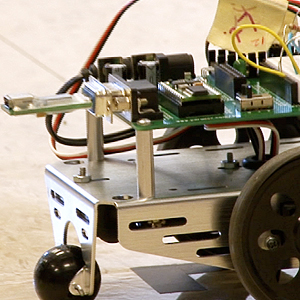Engineering the Future
Project Lead the Way gets kids excited about the field of engineering.

Lights dimmed, desks cluttered with wires and pieces of metal, floors marked with tape, the space abuzz with a whirrrrrr, whirrrrrrr, buzzzzzzz, click, and, ultimately, laughter.
At first glance, it looks like a room full of misplaced adults experimenting with children’s toys. But there is a purpose to their playful pursuits. These are middle and high school teachers engaged in serious learning about how to make engineering fun during a two-week boot camp at San Diego State University.
“I have been getting an advanced training in electrical engineering, aerospace, mechanical engineering, programming, design and modeling,” said Jose Lara, a teacher at Horace Mann Middle School and participant in SDSU’s Project Lead the Way (PLTW) summer training program. “All these courses will help me to teach students the principles of engineering that will help them in high school as well as college.”
A surplus of jobs
Lara believes steering students toward careers in engineering opens a door to an entire industry where a surplus of high paying jobs awaits.
And while other industries are struggling to keep their workforce intact, engineering firms have an immediate need for well-trained, technologically savvy young people, said Bruce Westermo, a professor in SDSU’s College of Engineering.
“As a country we are lagging behind in producing engineers per capita, particularly in areas such as aerospace, which is required to hire U.S. citizens.”
America’s shortage of engineering professionals led to the establishment of Project Lead the Way nearly 16 years ago. Support from corporate America helped the program expand to nearly every state, and passionate educators embraced it—first in 12 California schools, then in 160, and this year in 235 schools across the state.
Project Lead the Way prepares students to be leaders in science, technology, engineering and mathematics—the so-called STEM disciplines from which invention and innovation spring. The program partners with middle schools and high schools to provide rigorous, relevant STEM education that encourages the development of problem-solving skills, critical thinking, creative and innovative reasoning and a love of learning.
SDSU's role in Project Lead the Way
As PLTW’s affiliate institute for the state of California, SDSU is responsible for teacher training, counselor conferences, professional development workshops and “just about everything we can do to support them,” said Westermo, who helped bring the program to California nine years ago. He continues to introduce the program to additional schools throughout the state, and to find corporate sponsors to help it grow.
“The state department of education can’t provide support for Project Lead the Way,” said Westermo. “So our task is to go out and get corporate sponsors.”
Last year Qualcomm gave $450,000 to the College of Engineering, $100,000 of which went directly to PLTW. Chevron and General Atomics have also been generous. Ultimately, these companies reap the benefits of a larger, highly skilled workforce.
It all starts in the middle and high school level. At its core, Project Lead the Way aims to empower teachers to inspire kids.
During the summer workshops on SDSU’s campus, middle and high school teachers experiment with firing off water rockets, launching hot air balloons, building robots that follow paths and turn corners and constructing Rube Goldberg machines to explore kinetic and potential energy transfer.
“In the beginning my students would have very little notion of what engineering incorporated,” said Lara, who earlier delighted in his demonstration of an air pressured model car launch. “Then they started to see that it was project based, that it was fun, that they also got a chance to learn. And finally they understood the connection between their math classes and their science courses. It’s a program that is selling itself.”
Inspring young students
Ricky Le-Nguyen was sold during his senior year at Patrick Henry High School. Le-Nguyen has a talent for mathematics and a passion for art. He always thought he would become a dentist or a doctor until Kathy Schulze, a math teacher at Patrick Henry, encouraged him to enroll in her Principles of Engineering class.
“It opens the door for all high school students to explore the world of engineering,” said Le-Nguyen, now a fourth year mechanical engineering student at SDSU. “I don’t think in high school there are many opportunities for students to do that.”
More than 500,000 students like Le-Nguyen at nearly 3,500 schools across the country have taken part in PLTW classes. By the 2015-16 school year, the program hopes to reach more than 1 million students annually. That’s good news because PLTW graduates are five to 10 times more likely than non-PLTW graduates to study postsecondary engineering and technology, and 97 percent of PLTW seniors intend to pursue four-year degrees.
“Is it fun? Yes,” Lara said as a band saw buzzed behind him, carving out a machine component. “But what’s more important is that students are learning. They’re achieving, they’re excited about coming to school and they’re excited about going into the field of engineering.”



